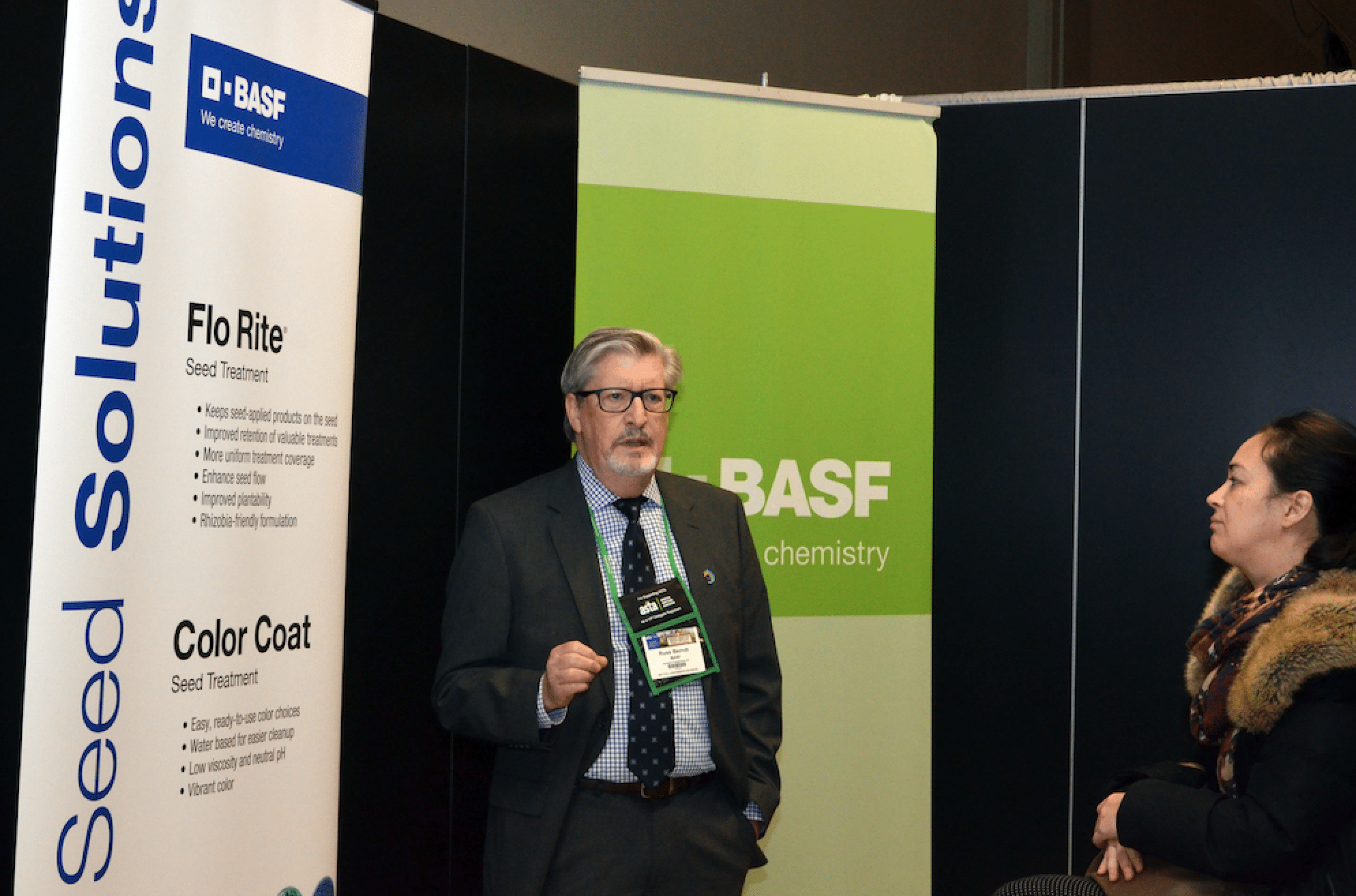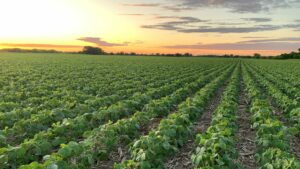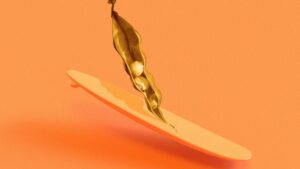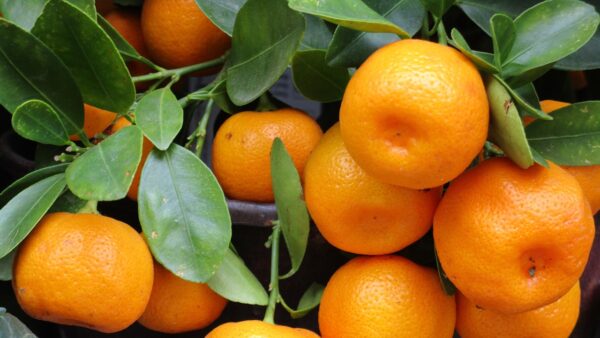Seed treatment advancements aren’t limited to companies that create chemistry; it involves everything from manufacturers to testing.
Seed technology and advancements in the industry were the focus of a new Seed Expo tour, hosted by the American Seed Trade Association during its annual Corn, Sorghum and Soybean Seed Research Conference in Chicago. The tour included stops with 10 exhibitors that are involved in the seed treatment space from beginning to end. They talked about everything from the importance of eliminating dust to dust-off testing, and from safety to new chemistries coming to the marketplace.

To start the seed treatment process, having clean seed is essential to achieving accurate application rates, minimizing treatment buildup in equipment and eliminating seed clumping that can affect plantability.
“Operators need to make sure the seed is as clean as possible as it enters the seed treater,” says Jason Kaeb who serves as director of business development at KSi.
He explains that they use a seed filtering system connected to an air system to remove dust from the seed immediately before it goes into the treater. Kaeb says this is designed to prevent the buildup of treated dust at the atomizer.
He showed samples of fine dust, bees wings and other light weight material collected and removed from the seed filtering system.
“Treated dust is what hangs up in the seed handling system and planter,” Kaeb says. “You can’t assume that all the dust and light materials have been removed because the seed has been processed by an air screen.”
Jon Moreland, Petkus North America managing director, agrees that dust removal is a critical first step.
“One of the biggest difficulties I see in transitioning from conditioning to treating is lack of aspiration,” Moreland says. “Aspiration prior to treatment can eliminate buildup in a treater.
“In a bowl treater there is heavy, dense seed toward the bottom of the bowl and then chemicals, polymers and colorants are atomized into the atmosphere above the seed. These ingredients are designed to stick, mix and cover.”
Moreland explains that anywhere there isn’t movement in the seed treater, you usually find buildup from the seed treatment residue, which can include lightweight materials such as bees’ wings, dust or chaff.
Once the seed is clean and as much of the dust has been removed as can, there’s a whole host of products that can be applied on the seed, of which one is polymers.
Polymer Practicality
The primary function of polymers is to keep seed treatments where they belong: on the seed. Polymers added to the seed treatment slurry provide the adhesion necessary to keep treatments on the seed and off of nontargets.
Polymers also help reduce the drying time, so there is a shorter tack phase to prevent seed sticking and clumping during the treatment process.
Along with colorants, polymers provide a polished final appearance that adds aesthetic value to the seed once delivered to the farmer.
“Polymers reduce seed friction, which reduces dustoff and enhances the flow of the seed through handling equipment and planters, so you get a more accurate seed drop and better spacing with fewer skips,” says Russell Berndt, BASF product manager. “Research shows improved yields when seeds are planted with more uniform spacing.”
Once the seed treatment formula is applied, it must be properly dried.
Diligence in Drying
Wet seed costs businesses money. Whatever seed protection products are applied, they all have the same issue: the seed needs to be dried. If the seed is wet when it goes to packaging, it leaves costly treatment on the line.
The moisture has to be removed from the seed before it can be packaged.
“Wet seed does not benefit you or your customers,” Moreland says. “It clumps in the bag, transfers to the elevator, gets stuck in elevator cups and sticks to the drum.
“Then you let the seed stay in there and let the air dry it out. It gets tacky and then it starts getting stuck in there and builds up.”
He goes on to say at the end of the year, you pay employees to clean all this dried junk out treaters, elevators and bins.
“Remember that added value?” he asks. “It is not going where it belongs; it’s costing you money to clean it out.”
Whether in Europe or in the United States, as seed treatment rates go up, additional drying time is required.
“We think the best solution is an integrated dryer and treater,” Moreland says.
Attention to Safety
During the seed treatment process, employee safety is a must. However, experts say that when handling seed treatments daily, familiarity can lead to employee complacency.
Except for biological products, seed treatment ingredients are chemicals that can be harmful to employees when handled improperly.
“We talk about personal protective equipment (PPE) as we engage with customers about our seed treaters and seed treatment products,” says Kelli Brown, Bayer North America seed applied solutions portfolio manager. “It is important to remember that product labels are not suggestions, they are the law. They are there for users’ health and safety.
“We talk through some of the simple things, like what type of gloves should be used. It is not the little latex gloves you get at the corner drug store,” Brown continues. “When do you need two layers of clothing covering your skin? There are guidelines on every bag tag about what growers should be wearing but often times they are just not aware. So, we talk to them about wearing gloves, pants, long sleeves, socks and shoes. If customers do not want to wear protective clothing while planting treated seed, they should keep the required clothing items with them in the tractor cab so it is available to be worn when they handle treated seed.”
Employee training is as important as the equipment they are using. Companies urge managers responsible for seed treating operations to provide and document employee training.
“We have a flow meter option for our seed treating equipment that is used by 80 percent of our locations,” says Andy Renyer, USC LLC director of operations. “When properly calibrated, it meters within 0.5 percent of the targeted amount. It is the best option for a slurry type setup. Employee training is always important. Anytime you are using seed treating equipment you could be letting an inexperienced operator mix a lot of high-dollar products together.”
Testing Assurances
In the end, every seed treatment must in one way or another add value. It must improve something about that seed.
“There are a variety of analytical tests to determine that customers receive the products they’ve purchased,” says Amanda ver Helst, SGS laboratory research manager. “Dust-off evaluation is big.

“Will the treatment come off the seed when it goes into the planter? We can measure the amount of seed treatment that will dustoff as the seed is handled. We can also determine which components are in the dustoff material. Active ingredient analysis will determine whether the remaining treatments are hitting target application rates.”
Craig Nelson, Eurofins BioDiagnostics vice president, client services and marketing, agrees that there are plenty of reasons to test your seed.
In talking with seed industry professionals about conducting seed treatment loading rate analysis of their treated seed lots, Nelson says he is frequently asked why this testing would be important to them. He lays out six reasons when having this discussion.
To ensure the seed treatment chemicals are not under applied, risking loss of protection.
Applying excess treatment means more money is spent than necessary.
Excess seed treatment can damage seeds and hinder germination.
To manage liability and to protect your reputation in the industry.
To comply with local, state and federal laws.
To ensure that the seed performs as expected
in the field. Ultimately, treating seed at the labeled rate protects all stakeholders whether they are the grower, applicator, retailer or chemical company.
Seed companies are doing everything in their power to make sure that seed treatments are used correctly and safely, and testing facilities are working to ensure that everyone gets what they expect.
What’s New?
Saltro is a new chemistry from Syngenta for control of sudden death syndrome (SDS) in soybeans caused by fusarium. Saltro also has activity against several nematode species with less phytotoxicity than caused by earlier products.
Dale Ireland, Syngenta Seedcare technical product lead for U.S. corn and soybean, says Saltro easily goes into slurry with less tendency to build up on seed treating equipment and produces less dustoff to keep seed treatment on the seed. Commercial availability is scheduled for third quarter 2019.
Vayantis fungicide is another new product from Syngenta to help control Pythium and phytophthora in soybeans. Commercial availability is scheduled for first quarter 2020. Vayantis provides a new mode of action shown to be effective against all known isolates of all known species.
NemaStrike technology from Bayer, is a true nematacide chemistry for corn, soybeans and cotton. It is scheduled to launch in 2019. Key to NemaStrike’s effectiveness is that less than 3 percent of the active ingredient ever goes beyond the root zone and into the soil.
“This product controls nematodes up to 75 days through multiple generations,” Bayer’s Brown says. Originally scheduled for release in 2017, NemaStrike is now scheduled for release in 2019.
BioRise 2 corn is a new Bayer biological.
“Unlike most seed treatments which are defensive, this biological tends to be an offensive product,” Brown says. “It first releases phosphate that binds to other minerals in the soil. Over time, it will bind to calcium or magnesium. The penicillium in BioRise 2 will break those bonds so the fungi in the soil can take up the phosphate.
“The second component of this is LCO icooliosaccharide, which naturally stimulates beneficial fungi in the soil to colonize around the plant root hairs.”
Brown explains that they cannot make their own energy, so they pass water and soil nutrients to the plant in return for a tiny amount of carbohydrate. This symbiotic process continually extends the plants’ root system so the fungi can keep reaching water and nutrients.
Talking about new products, equipment advancements, safety and testing brings the seed treatment process into full view.













